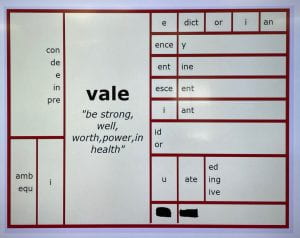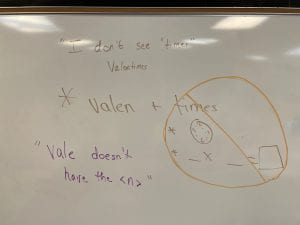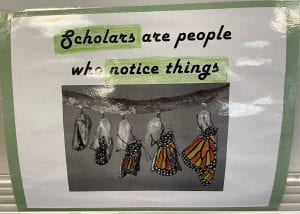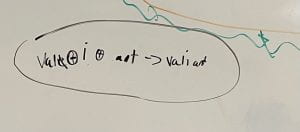My small group of grade 5 students entered the classroom with this on the Viewsonic screen:
As they settled in for the half hour session, they began to talk about this image. Today being Valentine’s Day, one student quickly surmised that we might be looking at a matrix about words that make <valentine>. However, what she said next stopped me in my tracks, causing us to consider a whole new aspect of the matrix I was about to explore with them. This student said, “I don’t see ‘times‘ in that matrix so we must not be studying *Valentimes.” I thought we were going to be building (synthesizing) words using morphemes from this matrix, but instead, we took the lead from my student to dive into misheard and misunderstood words. In various circumstances, I’ve often said,
“What we hear is not always what we see!”
In other words, our spelling system’s well-ordered structures may be masked by the spoken syllables or auditory processing and she just confirmed it. So we hypothesized the morphemes she thought were in this word and discussed possible meanings of <times> and those potential relationships with our word <valentine>. We then concluded that neither meaning of ‘time’ is related to our word.
The student then focused on the first morpheme, <*valen>. She compared that to the base written on the screen <vale> and said, “Vale does not have the <n>!” We are still working on spelling out elements instead of reading them as a whole unit, but I let that go as it was not the focus of this clump of understanding.
“You’re right!, there isn’t an <n> in <vale>” I said, “What do you make of that?” Interestingly, she did not say what I thought she was going to say. Instead she said, “Which means this word isn’t related to <vale> which is why I don’t see times.” Hmmm… I pondered. At this point, another student had popped up to kindly but admonishingly remind her not to be a smarty-pants. This prompted me to remember something I’m shocked I’d forgotten to get out for the past 5 months!! I said, “While she isn’t exactly on target with that statement, she does deserve to hold onto this poster. We are all scholars in this room because you notice things about words. Whether she’s right or not, by her sharing her thinking out loud, I now know what it is and can help clear up things she’s confused about or be able to tell her her thinking is spot-on.”
As I handed the poster to one student, I asked him, “Who is a scholar?” He smiled, sat up straighter and said, “ME!” In turn, we asked each of the students the same question, passing the poster until all had recognized him/herself as a scholar, landing with the student who had been sharing her thinking. This small moment is powerful. It let’s kids know that we don’t always have to answer correctly, we can simply notice things and then begin to learn even more. It frees them from the confinements of the fear of being wrong.
Back to the student’s interesting statement in which she claimed her hypothesis of <valen> was not the word we were studying on the screen. I expected her to tell us that her hypothesis was not correct because the base on the matrix on the screen was <vale>. Why would I make this assumption? I had given her no evidence. I simply anticipated she’d make the connection. When the students aren’t getting it, it isn’t them, it’s the teaching. Seeing this perspective allows me to ask productive questions instead of making a judgement of surprise that she didn’t get it. Judgements, however small, can have big implications on a student’s willingness to risk answering or expressing themselves. We went on to observing the matrix on the screen again — I highlighted the morphemes on the matrix that we use, then wrote a word sum to synthesize:
vale/ + ent + ine –> Valentine
We then discussed capitalizing this word since we are referring to it as the name of a holiday. Once students saw this connection, it led to a discussion about how syllables, which are spoken units, can mask or hide the connection in meaning and can be mushed in our auditory processing, causing us to hear words or syllables differently. I gave a few examples from my own kids — one mispronounced chocolate /ˈtʃɔk lɪk/ which, in case you aren’t familiar with IPA symbols, it sounded like “chaulk lick”. Another one of my kids, who as an adult still has trouble pronouncing correctly, says ‘ornament’ as /ˈoɹ dʌ ˌmənt/ which replaces /n/ with /d/. We mentioned the relationship of ornament, ornate and adorn and as we did so, the adult parapro in my room was audibly stunned — she informed us that she has always pronounced it like my daughter and was shocked by this new understanding. There was joy on her face as she processed this. There is huge value in kids seeing adults learning right along side them. Sometimes it’s me learning with them, sometimes it’s a parapro, an ESL interventionist, other students or even their teachers when they go back to class with new nuggets of information. We showed how the spelling remains consistent, even though we may pronounce them differently. We also practiced the phonetics of saying /m/ and /n/ and feeling the air pass through our nasal cavity. This helps us understand how easy it is to mix these two sounds up as they are the only ones that do that. We found the difference is where our lips meet for /m/ and that they are open with /n/. When you say /n/ in a word like Valentine, the first <n> is not a clear /n/ with the tongue touching the alveolar ridge the same way as the final <n> does. Knowing the spelling of the suffixes <-ent> and <-ine> can help us far more than sounding this word out. We also learned that there is no suffix <*-emt> or <*ime> so even if we can’t sound it out, we wouldn’t use an <m> in this word.
After this discussion, I set the students free to create word sums on the board, using morphemes from the matrix on the screen. The only catch, was to create words that they could use meaningfully in a sentence. Afterward, we analyzed each of their word sums to see if it made a real word and to see that they applied any necessary spelling conventions. A couple of the students needed more individualized help to remember to write morphemes that are in line with each other on the matrix (cannot skip a box, can only read/work the matrix left to right). The others were independent. One made a word that wasn’t real but tried very hard to make a sentence with it anyway, fun to see her try and realize she had to concede to making a word she understood. Below are a few examples of some of the words the students created:
I want to highlight the word sum, written in purple marker, because this student worked out the Replace the <e> Spelling Convention by annotating her thinking underneath (V = vowel suffix; SSF = Single, Silent, Final <e>).
The second student who followed the matrix and wrote: equ + i + vale/ + ent –> equivalent, did not know its meaning so we discussed it and drew some quick images to help her understand it.
Time was running very short so we ended the lesson but the lesson did not end there. As the students lined up to go back to their regular classrooms, I heard a few of them saying they were so surprised that there wasn’t an <m> in Valentine and that they couldn’t wait to tell someone else.
Happy Valentine’s Day!









